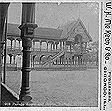![]()
Calvert Vaux
- Table of Contents
Calvert Vaux: The Unsung Hero of Landscape Architecture
By Francis R. Kowsky
Distinguished Professor of Art History, Buffalo State College
Reprinted with permission from the Buffalo Olmsted Parks Conservancy
TEXT Beneath Illustrations
Click on illustrations for larger size -- and additional information
|
Calvert Vaux |
Delaware Park boat house |
Delaware Park boat house |
|
|
Delaware Park boat house |
Delaware Park boat house |
Delaware Park boat house |
Delaware Park Spire Head House |
|
The Refectory, the Parade, 1875 |
Original Vaux Parade House which burned in 1876 |
Original Vaux Parade House which burned in 1876 |
Original Vaux Parade House which burned in 1876 |











